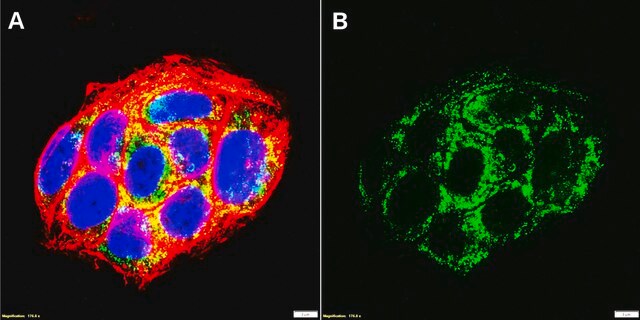01110916
E11
from Snakehead fish
Se connecterpour consulter vos tarifs contractuels et ceux de votre entreprise/organisme
About This Item
Code UNSPSC :
12352200
Produits recommandés
Source biologique
fish fish (whole)
Niveau de qualité
Mode de croissance
Adherent
Caryotype
Not specified
Morphologie
Fibroblast
Produits
Not specified
Récepteurs
Not specified
Technique(s)
cell culture | mammalian: suitable
Conditions d'expédition
dry ice
Température de stockage
−196°C
Origine de la lignée cellulaire
Snakehead fish, whole fry tissue
Description de la lignée cellulaire
E11 is a clone of the cell line SSN-1 and is persistantly infected with a C-type retrovirus (SnRV). It is susceptible to piscine nodavirus strains belonging to different genotypes (SJNNV, RGNNV, TPNNV and BFNNV - striped jack, red spotted grouper, tiger puffer and barfin flounder nervous necosis viruses repectively). E11 is highly permissive to nodavirus infection and production. An advantage of E11, over the parental line SSN-1, is its steady, faster growth to confluency and longer stability in monolayer cultures for 2 weeks at 25 °C or 4 weeks at 20 °C and its reproducible, clear CPE characterised by cytoplasmic vacuole formation followed by intensive disintegration.
Milieu de culture
L15 + 5% Fetal Bovine Serum (FBS)+ 2 mM Glutamine
Procédure de repiquage
Split sub-confluent cultures (70-80%) 1:4, ie., seeding at 3 x10,000 cells/cm2 using 0.05% trypsin/EDTA. No CO2. Culture at 25 °C
Autres remarques
Additional freight & handling charges may be applicable for Asia-Pacific shipments. Please check with your local Customer Service representative for more information.
Cultures from HPA Culture Collections and supplied by Sigma are for research purposes only. Enquiries regarding the commercial use of a cell line are referred to the depositor of the cell line. Some cell lines have additional special release conditions such as the requirement for a material transfer agreement to be completed by the potential recipient prior to the supply of the cell line. Please view the Terms & Conditions of Supply for more information.
Depositor and originator: Professor Toshihiro Nakai, PhD Laboratory of Fish Pathology Graduate School of Biosphere Science Hiroshima University 1-4-4 Kagamiyama, Higashi-Hiroshima Hiroshima 739-8528, Japan
For complete product information, please see ECACC
Clause de non-responsabilité
This cell line has special release conditions: All customers are required to complete a Cell line Release Authorisation form.
Code de la classe de stockage
10 - Combustible liquids
Classe de danger pour l'eau (WGK)
WGK 3
Point d'éclair (°F)
Not applicable
Point d'éclair (°C)
Not applicable
Certificats d'analyse (COA)
Recherchez un Certificats d'analyse (COA) en saisissant le numéro de lot du produit. Les numéros de lot figurent sur l'étiquette du produit après les mots "Lot" ou "Batch".
Déjà en possession de ce produit ?
Retrouvez la documentation relative aux produits que vous avez récemment achetés dans la Bibliothèque de documents.
T Iwamoto et al.
Diseases of aquatic organisms, 43(2), 81-89 (2001-01-06)
Six cell clones were derived from the SSN-1 cell line, which is composed of a mixed cell population and persistently infected with a C-type retrovirus (SnRV). These clones were susceptible to 4 piscine nodavirus strains belonging to different genotypes (SJNNV
Notre équipe de scientifiques dispose d'une expérience dans tous les secteurs de la recherche, notamment en sciences de la vie, science des matériaux, synthèse chimique, chromatographie, analyse et dans de nombreux autres domaines..
Contacter notre Service technique



